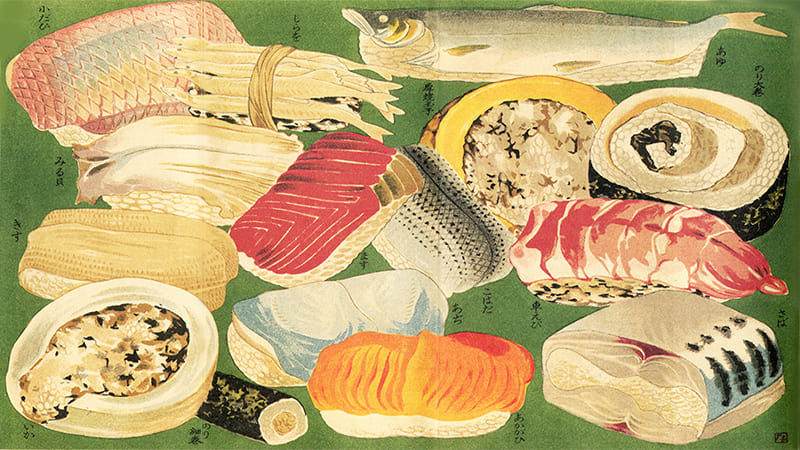About Kanda Sasazushi

Edomae Sushi at Sasazushi
Sasazushi offers traditional Edo-style sushi that has been passed down through generations.
Edo-style sushi generally refers to sushi made with fish caught in the vicinity of Tokyo Bay.
A distinctive feature of the sushi preparation is the extra step taken to preserve the fish, such as using "vinegar-zuke" and cooking.
At Sasazushi, we have placed importance on these additional steps.
While serving fresh seasonal fish as is can be delicious, we also offer prepared options as needed.
When it comes to finishing touches on Edo-style sushi, vinegar-zuke is essential.
Our finishing touch at Sasazushi is vinegar-zuke (without any kombu pre-treatment).
Sushi at Sasazushi as Seen in Hanaya Yohei's Sushi Drawings
The roots of Edo-style sushi are said to trace back to "Hanaya Yohei."
Above is a sushi illustration believed to depict the sushi made by Hanaya Yohei during the Edo period.
In the present day, we continue to handle sushi ingredients that are gradually being lost,
and many of the sushi ingredients depicted in the illustration are offered as seasonal items.
We hope you can casually enjoy our cherished Edo-style sushi.
Sweetfish (Illustration top right, "AyU")
We offer this for a limited time during the month of June.
The preparation method is the same as depicted in Hanaya Yohei's sushi illustration.
Kodai (Illustration top left, "Ko-dai")
We offer this as "Shunko (young snapper)" from around December to the end of May.
Shiromi (Illustration upper middle left, "Shiromi")
We offer this for a limited time during the month of March.
While the sushi illustration shows it with kanpyo (dried gourd strips), at our establishment, it's wrapped with seaweed.
We finish it with Japanese sake and refined white sugar for a sweet taste.
Tamago Yaki (Illustration middle right, "Atsu-yaki Tamago")
Although it's labeled as "Atsu-yaki Tamago," it appears different from the contemporary thick omelette.
Our tamago yaki is the "Authentic Edo-style Thin Omelette."
Nori Tamaki (Illustration right, "Nori Tamaki")
Looking at the sushi illustration, it seems the nori forms the character "no."
The oversized rolls that are commonly seen nowadays are based on the Kansai tradition of "Eho-maki" and not Edo-style.
While we don't usually offer regular nori tamaki, we provide it for reservations made a month in advance.
Mirugai (Illustration left, "Mirugai")
Akagai (Illustration bottom middle, "Akagai")
As representative shellfish in Edo-style cuisine, we offer these during the winter months.
Hirame/Flounder (Illustration middle left, "Hirame")
We offer this for a limited time, around a month, starting from May after the Golden Week holidays.
Masu Trout (Illustration lower middle left, "Masu")
While the traditional method used by Yohei involved only salt seasoning,
we offer it vinegar-marinated from March to around the end of May.
Kohada (Illustration in the center, "Kohada")
The sushi illustration shows a whole Kohada being used. Using one fish for a piece is known as "ikkan-dzuke."
In our establishment, we similarly offer Kohada ikkan-dzuke during the winter months.
We discontinue serving it when it starts to carry eggs, usually from February to March.
Car Ebi (Illustration middle right, "Car Ebi")
We offer simply salt-boiled Car Ebi (shrimp) throughout the year.
We also provide Vinegar-marinated shrimp.
Saba (Illustration bottom right, "Saba")
In the sushi illustration, it is depicted as a type of pressed sushi.
Similar to Kohada, we serve Saba during the winter months.
(We stop serving it when it starts to carry eggs, usually from February to March.)
Aji (Illustration lower middle, "Aji")
In the sushi illustration, it's Jin-ta (young horse mackerel) molded using a whole fish.
We offer it from around the beginning of May, after the Golden Week holidays, until the end of May.
Since the handling of Jin-ta is almost unheard of in other stores, it is considered quite rare.
You can enjoy it with the classic Edo-style sushi preparation, "Su-zuke."
"Do not speak of sushi without knowing Jin-ta."
Ika (Illustration bottom left, "Ika")
In the sushi illustration, it's depicted as "Ika Inro-tsumi," where dried cuttlefish (Surume Ika) is used.
In our establishment, we offer "Mugi Ika" (young cuttlefish) Inro-tsumi, which is available during the barley harvest season.
Nori Hosomaki (Illustration bottom left, "Nori Hosomaki")
When it comes to seaweed rolls in Edo-style sushi, it refers to "kanpyo maki."
Alongside tamagoyaki (sweet rolled omelette), kanpyo is an important element to understand the taste of a shop.
We meticulously prepare it using top-quality domestically-produced kanpyo.
